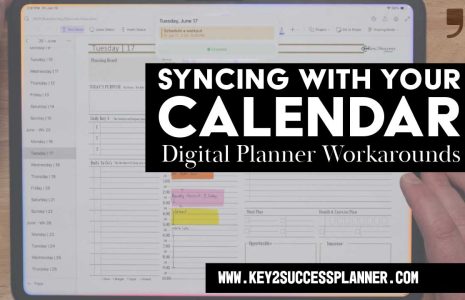OneNote Business Plan Template
The Key2Success Digital Planner’s Professional Builder can be a valuable tool to streamline and enhance the process of creating a business plan. This OneNote business plan template can also be found in PDF format for other applications in the Key2Success shop. Here’s how it can assist you in each step of the business plan development:
1. Vision Setting:
- The planner provides a dedicated space for you to articulate your vision, whether it’s for your career, personal life, family, or community.
- Helps you clarify and organize your ideas and goals, setting the foundation for your business concept.
2. Addressing Challenges:
- The section for “Key Boulders” allows you to identify and address challenges related to cash flow, staffing, education, or other aspects.
- Guides you in understanding the processes needed to overcome these challenges.
3. Identifying Resources:
- In the “Resources” section, you can outline your strengths and resources, extending beyond yourself to include organizations, friends, family, and neighbors.
- Helps you recognize the support system that will contribute to achieving your goals.
4. Defining Key Values and Vitals:
- Allows you to articulate your fundamental beliefs and hardwired values in the “Key Values” section.
- Provides a space for specifying measurable aspects of process and accountability with “Key Vitals.”
5. Long-term Planning:
- Encourages both short-term and long-term planning by providing a dedicated space to set a 10-year target.
- Ensures that your actions align with your overarching goals for sustained success.
6. Mitigating Risk with Absolutes:
- The “Absolutes” section is crucial for risk mitigation, helping you define non-negotiables and exit strategies.
- Assists in ensuring that your business remains resilient, even in challenging circumstances.
7. Individual Role and Accountability:
- Helps you determine your role in the business plan, articulating key actions and accountability measures.
- Guides you in establishing consistent patterns and processes for success.
8. Organizational Impacts and Adaptation Processes:
- Assists in understanding how success may impact your organization in the “Organizational Impacts” section.
- Guides you in creating adaptation processes and triggers for sustained growth.
9. Regular Reflection and Adjustment:
- The planner is designed for regular reflection, allowing you to revisit and make adjustments to your planning regimen.
- Provides a structured approach to ongoing refinement of your business plan.
10. Flexibility for Multiple Ventures:
- If you have multiple endeavors, the planner encourages you to duplicate the process for each business or organizational role, ensuring a comprehensive approach to planning.
Conclusion:
The Key2Success Digital Planner’s Professional Builder is a comprehensive tool that integrates essential elements of business planning into a structured, easy-to-use format. By leveraging its features, you can create a dynamic and effective business plan while maintaining flexibility for ongoing adjustments and reflections. Whether you’re a seasoned entrepreneur or just starting, the Professional Builder can be a valuable companion in your business planning journey.
What is a Business Plan?
Writing a business plan is a crucial step in launching or growing a business. It serves as a roadmap, helping you define your business, set goals, and create strategies for success. Here’s a step-by-step guide on how to write a business plan:
1. Executive Summary:
Overview: Provide a brief overview of your business, including its name, location, mission statement, and a summary of your products or services.
Business Concept: Explain the concept of your business, its uniqueness, and the problem it solves or the need it addresses in the market.
2. Company Description:
History and Current Status: Provide background information on how your business started, its current status, and any notable achievements.
Mission and Vision Statements: Clearly state your business’s mission and vision, outlining its purpose and long-term objectives.
3. Market Analysis:
Industry Overview: Describe the industry your business operates in, including trends, growth potential, and key players.
Target Market: Identify your target audience, their demographics, and preferences. Explain how your products or services meet their needs.
Competitor Analysis: Analyze your competitors, their strengths and weaknesses, and how your business will differentiate itself.
4. Organization and Management:
Company Structure: Outline your business’s legal structure (e.g., sole proprietorship, LLC, corporation) and provide details on key team members.
Roles and Responsibilities: Clearly define the roles and responsibilities of each team member.
5. Products or Services:
Description: Provide detailed descriptions of your products or services, including their features, benefits, and unique selling points.
Development and Life Cycle: Explain the development stage and life cycle of your products or services.
6. Marketing and Sales:
Marketing Strategy: Outline your marketing plan, including your target audience, pricing strategy, distribution channels, and promotional activities.
Sales Strategy: Describe how you’ll sell your products or services, including your sales team, sales channels, and customer relationship management.
7. Funding Request (if applicable):
- Funding Requirements: If you’re seeking funding, specify the amount you need, how you’ll use it, and the terms you’re offering to investors.
8. Financial Projections:
Revenue Projections: Provide detailed financial projections, including income statements, balance sheets, and cash flow statements for at least the next three to five years.
Break-even Analysis: Determine when your business is expected to become profitable.
9. Appendix:
- Additional Information: Include any additional information, such as resumes of key team members, detailed market research, or other supporting documents.
Tips for Writing a Business Plan:
Be Concise: Keep your business plan clear and concise. Avoid unnecessary jargon or technical language.
Be Realistic: Ensure that your financial projections and goals are realistic and based on thorough research.
Review and Revise: Regularly review and update your business plan as your business evolves and market conditions change.
Seek Feedback: Get feedback from mentors, advisors, or others in your industry to improve your business plan.
Writing a business plan takes time and careful consideration. It’s a dynamic document that should evolve as your business grows and changes. Use this guide as a starting point, and customize your plan to fit the unique needs of your business.












